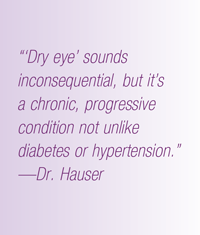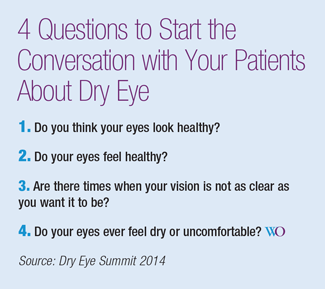

By Whitney Hauser, OD, Founder, Signal Ophthalmic Consulting
If you think dry eye disease is a nuisance, you aren’t alone. Your patients wholeheartedly agree. While they may stumble and
stutter over the 20/25 line in your exam room, it really only takes a few extra minutes out of your day. Consider what it does to theirs. What is it like to read lines on a spreadsheet or drive a minivan full of kids when you have fluctuating vision? Decreased acuity is one the most common complaints of dry eye disease sufferers. Unfortunately, eye care providers try to alleviate the problem with changing
contact lens materials or suggesting artificial tears alone. We offer the weakest solutions to a sometimes life-altering condition.
Dry eye disease is just that. A disease. Regrettably, “dry eye” sounds inconsequential, but it’s a chronic, progressive condition not
unlike diabetes or hypertension. Similar to those pathologies, it affects millions of people with no cure in sight.1 Effective treatments are available, and more are in the pipeline to combat the primary root of the problem: inflammation.


The signs that doctors see and the symptoms patients feel begin at a cellular level. We think in terms of lacrimal gland and
meibomian gland dysfunction as clinicians. However, the impetus of inflammation is appreciated at a microscope before its impact
is seen at the slit lamp. Ocular surface stress and damage trigger an acute inflammatory response. The body’s innate reaction to the
initial insult is a release of acute response cytokines that increase inflammatory cell production, expression of intercellular adhesion
molecules and activation of antigen presenting cells.2 T cells migrate to ocular surface tissues and potentiate a chronic autoimmune response that results in a decrease in goblet cell density and apoptosis. This inflammatory domino effect results in overexpression of MMP3 and MMP9 (matrix metalloproteinase) and breakdown of the epithelium.2 What begins as an acute response morphs into a state of perpetual inflammation and, clinically, into a chronic and progressive ocular surface disease.


In bustling practices, it’s often hard to see the forest for the trees. We bounce from exam room to exam room transitioning from glaucoma rechecks to pediatric refractions to contact lens fits. The transient blur of a mild to moderate dry eye patient is only a whisper in all of the noise. It’s easy to think of dry eye as an insignificant complaint rather than the disease that it is. Perhaps we should pause the next time we hear a patient say, “I’ve noticed my vision is fluctuating more, and my eyes are always red,” and imagine what’s happening under the microscope and the vicious cycle that follows. Not only would we be more sympathetic doctors but we may also offer more thoughtful and effective treatments.
1 http://www.census.gov/prod/cen2010/briefs/c2010br-03.pdf
2 Stern, Michael E., Chris S. Schaumburg, and Stephen C. Pflugfelder. “Dry Eye as a Mucosal Autoimmune Disease.” International
Reviews of Immunology. Informa Healthcare, Feb. 2013. Web. 06 Feb. 2016.



